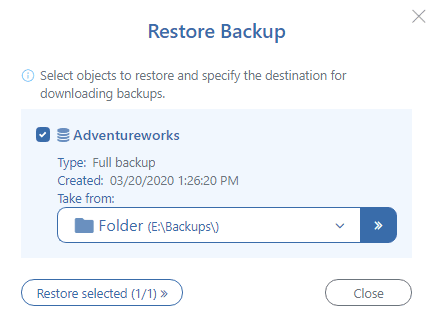You’ve recently come across a peculiar type of file with a .bak extension, and you know you are supposed to restore it in order to get the data.
This article will show you what to do in case you have such a file, and you need to open it to access the information.Backup best practices — a shortcut
 We already know that backups are important for securing your databases from data loss.
We also have an article about best practices regarding backups, but the article is quite detailed and if you want to take a shortcut and take care of the essentials, then you’ve found it here.
We already know that backups are important for securing your databases from data loss.
We also have an article about best practices regarding backups, but the article is quite detailed and if you want to take a shortcut and take care of the essentials, then you’ve found it here.
The media family on device is incorrectly formed
If you encounter the error message, “the media family on device is incorrectly formed. SQL Server cannot process this media family,” you may not initially understand exactly what happened.
This post will try to give you a few suggestions as to what might have gone wrong and what to do in those situations.
Backup best practices – a shortlist
 If you’re here, then there’s a high chance you already know the importance of good backups and what they mean to a serious business.
If you’re here, then there’s a high chance you already know the importance of good backups and what they mean to a serious business.Taking care of database backups is an important and very sensitive job.
This is why we tried to make a shortlist of some backup best practices that you should be aware of when you’re either doing backups or you’re trying to restore them, in order to be covered for any of the common and slightly uncommon situations involving backups.
Learn SQL #3 : SQL Commands
Now that we know how SQL works in a database system, it is now time to learn what sql commands (code) we need to write for specific operations.
As we said in our previous post, SQL gives you complete power over your data. But what does this mean exactly? We have many types of commands which allow you to do different operations with your data.
Learn SQL #2 : How is data stored in a database?
Learn SQL #1: What is SQL?
Restore SQL Server database remotely
 Imagine how cool would it be: you are on vacation on a beach when you receive a panicked email from your client telling you he has lost all his data. You take your smartphone, log in to sqlbak.com, press “Restore” next to the last backup, and in a few minutes tell the client that his database was restored. This is as close to James Bond as a database administrator could ever get!
Imagine how cool would it be: you are on vacation on a beach when you receive a panicked email from your client telling you he has lost all his data. You take your smartphone, log in to sqlbak.com, press “Restore” next to the last backup, and in a few minutes tell the client that his database was restored. This is as close to James Bond as a database administrator could ever get!
Backup the Tail of the Transaction Log
Tail-Log Backups
 In this article, we will offer information about tail-log backups, a feature that is available for SQL Server versions 2005 and newer. This is a topic which you should be aware of if your backup and restore process for your SQL Server databases is using either the FULL or Bulk-Logged recovery model.
In this article, we will offer information about tail-log backups, a feature that is available for SQL Server versions 2005 and newer. This is a topic which you should be aware of if your backup and restore process for your SQL Server databases is using either the FULL or Bulk-Logged recovery model.


